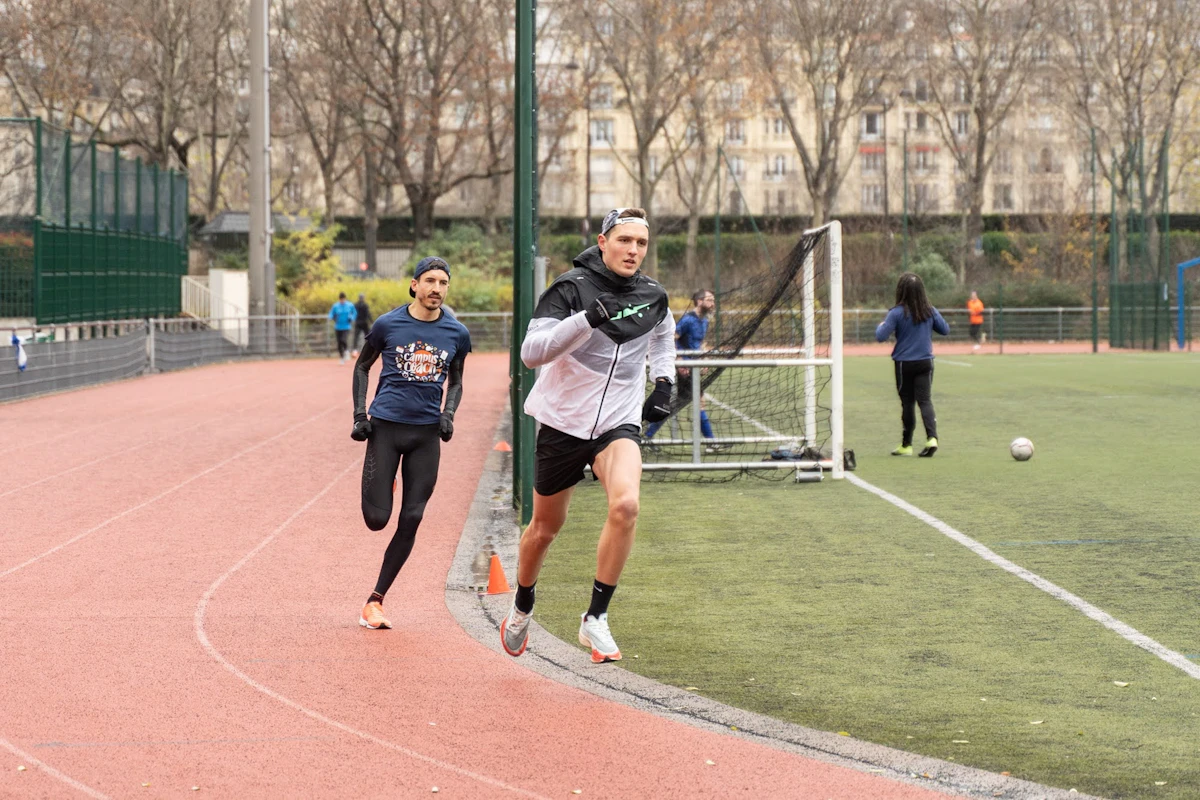How to determine your marathon split times?

7 min read
Summary
Determine your chronometric goal for the marathon
What is the average time for a marathon?
How to set a realistic goal? How to define what's a good marathon time?
The formula to calculate your marathon pace in min/km
Calculate your pace instead of your speed,
What time per kilometer for a marathon in 4 hours ?
Establish your split times with your marathon pace
Guidelines every 5 kilometers to validate the management of your pace throughout the entire marathon duration
Paces in marathon, how to calculate a speed? In min/km or in km/h?
Running pace tables

Receive advice from our passionate coaches!
Knowing your pace and maintaining a steady rhythm while running are key factors in running, especially when training for a marathon. Hence the importance of knowing your split times. By tracking them at regular intervals, you give yourself every chance of achieving your goal on race day.
Beforehand, you will have set your chronometric goal and calculated your target pace. This <0>marathon pace that you will work on and assimilate throughout your preparation. You can then define your split times. These will be valuable benchmarks on race day. They will help you stay on track, focused on your goal.
Determine your chronometric goal for the marathon
What is the average time for a marathon?
4 hours 29 minutes and 53 seconds. This is the average time it takes runners around the world to complete the classic distance of 42.195 km in a marathon. A RunRepeat study analyzed data from over 1.3 million marathoners in 2018. The average time for men is 4 hours 21 minutes, and for women 4 hours 48 minutes. French runners are slightly faster than the global average, with an average time of 4 hours 13 minutes.
How to set a realistic goal? How to define what's a good marathon time?
If you are new to<0> marathon running, you can use your times for shorter distances as a guide. For instance, a time achieved on your last 10 km or half-marathon will give a good indication and help you define your chronometric goal. It can then be refined as you prepare for your marathon.
So if you ran your last half marathon in 1 hour 45 minutes. It would be very ambitious to aim for a time of 3 hours 30 minutes on your first marathon. There will always be time to aim for this goal once you have become familiar with this distance. Experience is important in marathons. Conversely, a goal around 4 hours seems more appropriate and achievable given your past performances and unfamiliarity with the distance.
Your goal will also be determined based on your ability to train and the volume you can accumulate over the period, but don't panic, you can count on Campus to develop a personalized training plan.

The formula to calculate your marathon pace in min/km
To manage your race effectively and track your progress throughout your marathon training, it is useful to calculate your target speed, but above all your pace. Here's why.
Calculate your pace instead of your speed,
In running, it is preferable to express your pace in minutes per kilometer rather than in km/h.
Pace allows you to locate yourself more easily during a workout or a race. Because it gives you the time for one kilometer and allows better visualization. Ultimately, it's the average speed that you'll have to maintain for 42.195 kilometers, for example.
What time per kilometer for a marathon in 4 hours ?
To calculate your target pace for the marathon, simply divide your goal time expressed
in seconds by 42.195. Taking a chronometric goal of 4 hours (1h = 3600 sec), use the following formula to calculate your pace:
4 x 3600 / 42.195 = 341 seconds
Then convert this duration into minutes and seconds. You get an average pace of 5 minutes and 41 seconds per kilometer, rounded to 5'40.
Now, you have a good benchmark. In the final months of your training plan, you will learn to master this marathon paceof 5'40 per kilometer over increasingly longer intervals. This pace will become increasingly comfortable, until you feel able to sustain this cruising speed for several hours.
Establish your split times with your marathon pace
Once you have calculated your target pace, the idea is not to keep an eye glued to your watch throughout the race. You can simply check at regular intervals that you are indeed on track. That's the whole purpose of having established your split times as valuable benchmarks.
Guidelines every 5 kilometers to validate the management of your pace throughout the entire marathon duration
You can, for example, calculate your split times every 5 kilometers, as well as your time at halfway when you have completed your first half-marathon (21.1 km).
Your pace of 5'40 / km corresponds to intervals of 28 minutes and 20 seconds every 5
km. During a race, rely on the organization's kilometer markers rather than the distance on your watch.
Advice from the coach
Your race strategy will be to cover each 5 km segment without deviating too much from this reference time. You can, of course, allow yourself a small timing margin depending on the specifics of the course, such as elevation and particular conditions, like a headwind.
The general idea is to smooth out your effort as much as possible in order to avoid energy-consuming changes in pace. You will need it at the end of the race. Often, with the excitement of the start and the adrenaline rush, runners tend to start too fast, well beyond their marathon pace, and regret it later. Do you want
to put all the odds in your favor? Then follow this valuable advice from experienced marathoners: (The marathon really begins after 30 kilometers). Until then, it's better to stay focused on your split times.

Paces in marathon, how to calculate a speed? In min/km or in km/h?
To give you an idea of what marathon times represent, we have chosen four target times for demonstration purposes. For example, we also calculated in km/h, although for running, it is more accurate to analyze your pace (min/km) than your speed (km/h).
With a goal of about 4 hours, the target pace is 5'41 min/km, which is 10.55 km/h.
For a target time of 3 hours 45 minutes, the target pace is 5:19 min/km, or 11.25 km/h.
If you want to get closer to 3 hours, then you will need to aim for: 4'15 min/km, or 14 km/h.
Finally, you aim to break the 3-hour mark and complete the 42.195 km in no less than 2 h 45, your target pace will be 3'54 min/km or 15.34 km/h.
Running pace tables
Km | Goal 4:00 | Goal 3 hours 45 minutes | Goal 3 hours | Goal 2 hours 45 minutes |
|---|---|---|---|---|
3 | 17'03 | 15'59 | 12'47 | 11'43 |
5 | 28'26 | 26'39 | 21'19 | 19'33 |
10 | 56'52 | 53'19 | 42'39 | 39'06 |
15 | 1h25'19 | 1h19'59 | 1h03'59 | 58'39 |
20 | 1h53'45 | 1h46'38 | 1h25'19 | 1h18'12 |
25 | 2h22'11 | 2h13'18 | 1h46'38 | 1h37'45 |
30 | 2h50'38 | 2h39'58 | 2h07'58 | 1h57'18 |
35 | 3h19'04 | 3h06'38 | 2h29'18 | 2h16'51 |
40 | 3h47'30 | 3h33'17 | 2h50'38 | 2h36'25 |
Marathon | 4:00 | 3:45 | 3:00 | 2:45 |
To find out what goal you can aim for based on your previous personal bests, Campus has the perfect tool: its pace calculator.
Finally, to take things further, we've put together a short video reminding you of the importance of working on your pace, particularly your marathon pace, during training, but also the limitations of this technique:







